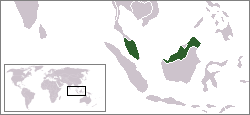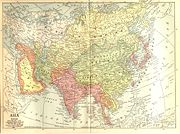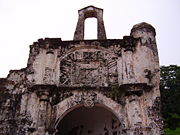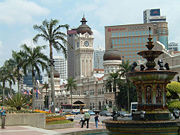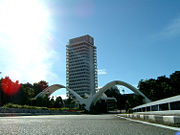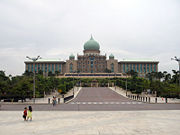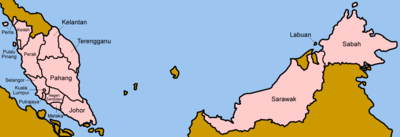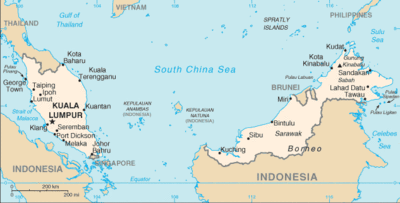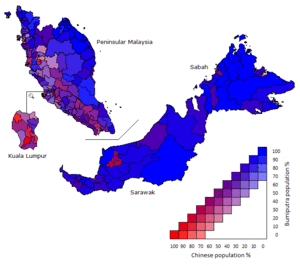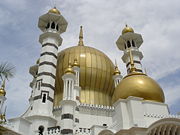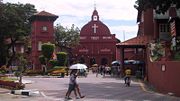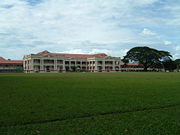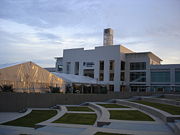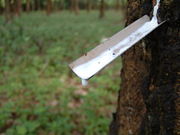Malaysia
2008/9 Schools Wikipedia Selection. Related subjects: Asia; Asian Countries
| Malaysia | ||||||
|---|---|---|---|---|---|---|
|
||||||
| Motto: "Bersekutu Bertambah Mutu" "Unity Is Strength"1 |
||||||
| Anthem: Negaraku "My Country"1 |
||||||
|
|
||||||
| Capital (and largest city) |
Kuala Lumpur |
|||||
| Official languages | Malay2 | |||||
| Demonym | Malaysian | |||||
| Government | Federal constitutional monarchy and Parliamentary democracy | |||||
| - | Yang di-Pertuan Agong | Mizan Zainal Abidin | ||||
| - | Prime Minister | Abdullah Ahmad Badawi | ||||
| Independence | ||||||
| - | from the United Kingdom ( Malaya only) |
31 August 1957 |
||||
| - | Federation (with Sabah, Sarawak and Singapore4) |
16 September 1963 |
||||
| Area | ||||||
| - | Total | 329,847 km² ( 67th) 127,355 sq mi |
||||
| - | Water (%) | 0.3 | ||||
| Population | ||||||
| - | Feb 2008 estimate | 27,496,000 ( 43rd) | ||||
| - | 2000 census | 24,821,286 | ||||
| - | Density | 83/km² ( 110th) 216/sq mi |
||||
| GDP ( PPP) | 2007 estimate | |||||
| - | Total | $357.9 billion ( 29th) | ||||
| - | Per capita | $14,400 ( 57th) | ||||
| GDP (nominal) | 2007 estimate | |||||
| - | Total | $165 billion ( 41st) | ||||
| - | Per capita | $6,648 ( 63rd) | ||||
| Gini (2002) | 46.1 | |||||
| HDI (2007) | ▲ 0.811 (high) ( 63rd) | |||||
| Currency | Ringgit (RM) ( MYR) |
|||||
| Time zone | MST ( UTC+8) | |||||
| - | Summer ( DST) | not observed ( UTC+8) | ||||
| Internet TLD | .my | |||||
| Calling code | +60 | |||||
| 1 | Malaysian Flag and Crest from www.gov.my. | |||||
| 2 | The current terminology as per government policy is Bahasa Malaysia (literally Malaysian language) ref but legislation continues to refer to the official language as Bahasa Melayu (literally Malay language). | |||||
| 3 | Putrajaya is the primary seat of government. | |||||
| 4 | Singapore became an independent country on 9 August 1965. | |||||
Malaysia (pronounced /məˈleɪʒə/ or /məˈleɪziə/) is a country that consists of thirteen states and three federal territories in Southeast Asia with a total landmass of 329,847 square kilometres (127,355 sq mi). The capital city is Kuala Lumpur, while Putrajaya is the seat of the federal government. The population stands at over 25 million. The country is separated into two regions — Peninsular Malaysia and Malaysian Borneo — by the South China Sea. Malaysia borders Thailand, Indonesia, Singapore, Brunei and the Philippines. The country is located near the equator and experiences a tropical climate. Malaysia is headed by the Yang di-Pertuan Agong and politically led by a Prime Minister. The government is closely modeled after the Westminster parliamentary system.
Malaysia as a unified state did not exist until 1963. Previously, a set of colonies were established by the United Kingdom from the late eighteenth century, and the western half of modern Malaysia was composed of several separate kingdoms. This group of colonies was known as British Malaya until its dissolution in 1946, when it was reorganized as the Federation of Malaya and later recognized as an independent nation in 1957. Singapore, Sarawak, British North Borneo and the Federation of Malaya joined to form Malaysia on 16 September 1963. The early years of the new union were marred by an armed conflict with Indonesia and the expulsion of Singapore. The Southeast Asian nation experienced an economic boom and underwent rapid development during the late 20th century. With a GDP per capita standing at USD13,000, it has, from time to time, been considered a newly industrialized country. As one of three countries that control the Strait of Malacca, international trade plays a large role in its economy. At one time, it was the largest producer of tin, rubber and palm oil in the world. Manufacturing has a large influence in the country's economy.
The Malays form the majority of the population. Some Malays are of Arab descent and there are sizable Chinese and Indian communities. Islam is the largest as well as the official religion of the federation. The Malay language is the official language. Malay was originally written in Jawi, based on Arabic script, but nowadays, the Roman alphabet (Rumi) is more often used.
Malaysia is a founding member of the Association of Southeast Asian Nations and participates in many international organizations such as the United Nations. As a former British colony, it is also a member of the Commonwealth of Nations. It is also a member of the Developing 8 Countries.
Etymology
The name "Malaysia" was adopted in 1963 when the Federation of Malaya, Singapore, North Borneo and Sarawak formed a 14-state federation. However the name itself had been vaguely used to refer to areas in Southeast Asia prior to that. A map published in 1914 in Chicago has the word Malaysia printed on it referring to certain territories within the Malay Archipelago. The Philippines once contemplated naming their state "Malaysia", but Malaysia adopted the name first in 1963 before the Philippines could act further on the matter. Other names were contemplated for the 1963 federation. Among them was Langkasuka ( Langkasuka was an old kingdom located at the upper section of the Malay Peninsula in the first millennium of the common era).
Even farther back into history, the English ethnologist George Samuel Windsor Earl in volume IV of Journal of the Indian Archipelago and Eastern Asia in 1850 proposed to name the islands of Indonesia as Melayunesia or Indunesia though he favored the former.
History
Prehistory
Archaeological remains have been found throughout Peninsular Malaysia, Sabah and Sarawak. The Semang have a deep ancestry within the Malay Peninsula, dating to the initial settlement from Africa over 50,000 years ago. The Senoi appear to be a composite group, with approximately half of the maternal lineages tracing back to the ancestors of the Semang and about half to Indochina. This is in agreement with the suggestion that they represent the descendants of early Austronesian speaking agriculturalists, who brought both their language and their technology to the southern part of the peninsula approximately 5,000 years ago and coalesced with the indigenous population. The Aboriginal Malays are more diverse, and although they show some connections with island Southeast Asia, some also have an ancestry in Indochina around the time of the Last Glacial Maximum, followed by an early-Holocene dispersal through the Malay Peninsula into island Southeast Asia.
Early history
Ptolemy showed the Malay Peninsula on his early map with a label that translates as "Golden Chersonese", the Straits of Malacca were referred to as "Sinus Sabaricus". From the mid to the late first millennium, much of the Peninsula as well as the Malay Archipelago were under the influence of Srivijaya.
There were numerous Malay kingdoms in the 2nd and 3rd century CE—as many as 30 according to Chinese sources. Kedah—known as Kedaram, Cheh-Cha (according to I-Ching) or Kataha, in ancient Pallava or Sanskrit—was in the direct route of invasions of Indian traders and kings. Rajendra Chola, Tamil Emperor who is now thought to have laid Kota Gelanggi to waste, put Kedah to heel in 1025 but his successor, Vir Rajendra Chola, had to put down a Kedah rebellion to overthrow the invaders. The coming of the Chola reduced the majesty of Srivijaya which had exerted influence over Kedah and Pattani and even as far as Ligor.
The Buddhist kingdom of Ligor took control of Kedah shortly after, and its King Chandrabhanu used it as a base to attack Sri Lanka in the 11th century, an event noted in a stone inscription in Nagapattinum in Tamil Nadu and in the Sri Lankan chronicles, Mahavamsa. During the first millennium, the people of the Malay Peninsula adopted Hinduism and Buddhism and the use of the Sanskrit language until they eventually converted to Islam.
There are reports of other areas older than Kedah—the ancient kingdom of Gangga Negara, around Beruas in Perak, for instance, pushes Malaysian history even further into antiquity. If that is not enough, a Tamil poem, Pattinapillai, of the second century CE, describes goods from Kadaram heaped in the broad streets of the Chola capital. A seventh century Sanskrit drama, Kaumudhimahotsva, refers to Kedah as Kataha-nagari. The Agnipurana also mentions a territory known as Anda-Kataha with one of its boundaries delineated by a peak, which scholars believe is Gunung Jerai. Stories from the Katasaritasagaram describe the elegance of life in Kataha.
In the early 15th century, the Malacca Sultanate was established under a dynasty founded by Parameswara or Sultan Iskandar Shah, a prince from Palembang with bloodline related to the royal house of Srivijaya, who fled from Temasek (now Singapore). Parameswara decided to establish his kingdom in Malacca after witnessing an astonishing incident where a white mouse deer kicked one of his hunting dogs into a nearby river. He took this show of bravery by the mouse deer as a good sign and named his kingdom "Melaka" after the tree under which he was resting at the time. At its height, the sultanate controlled the areas which are now Peninsular Malaysia, southern Thailand ( Patani), and the eastern coast of Sumatra. It existed for more than a century, and within that time period Islam spread to most of the Malay Archipelago. Malacca was the foremost trading port at the time in Southeast Asia.
The first evidence of Islam in the Malay Peninsula dates from the 14th century in Terengganu, but according to the Kedah Annals, the 9th sultan of Kedah, Maharaja Derbar Raja, converted to Islam and changed his name to Sultan Muzaffar Shah. In 1511, Malacca was conquered by Portugal, which established a colony there. The sons of the last Sultan of Malacca established two sultanates elsewhere in the peninsula—the Sultanate of Perak to the north, and the Sultanate of Johor (originally a continuation of the old Malacca sultanate) to the south. After the fall of Malacca, three nations struggled for the control of Malacca Strait: the Portuguese (in Malacca), the Sultanate of Johor, and the Sultanate of Aceh. This conflict went on until 1641, when the Dutch (allied to the Sultanate of Johor) gained control of Malacca.
British arrival
Britain established its first colony in the Malay peninsula in 1786, with the lease of the island of Penang to the British East India Company by the Sultan of Kedah. In 1824, the British took control of Malacca following the Anglo-Dutch Treaty of 1824 which divided the Malay Archipelago between Britain and the Netherlands, with Malaya in the British zone. In 1826, Britain established the crown colony of the Straits Settlements, uniting its three possessions in Malaya: Penang, Malacca and Singapore. The Straits Settlements were administered under the East India Company in Kolkata until 1867, when they were transferred to the Colonial Office in London.
During the late 19th century, many Malay states decided to obtain British help in settling their internal conflicts. The commercial importance of tin mining in the Malay states to merchants in the Straits Settlements led to British government intervention in the tin-producing states in the Malay Peninsula. British gunboat diplomacy was employed to bring about a peaceful resolution to civil disturbances caused by Chinese gangsters and Malay gangsters, and the Pangkor Treaty of 1874 paved the way for the expansion of British influence in Malaya. By the turn of the 20th century, the states of Pahang, Selangor, Perak, and Negeri Sembilan, known together as the Federated Malay States (not to be confused with the Federation of Malaya), were under the de facto control of British Residents appointed to advise the Malay rulers. The British were "advisers" in name, but in reality they exercised substantial influence over the Malay rulers.
The remaining five states in the peninsula, known as the Unfederated Malay States, while not directly under rule from London, also accepted British advisers around the turn of the 20th century. Of these, the four northern states of Perlis, Kedah, Kelantan and Terengganu had previously been under Siamese control. The other unfederated state, Johor, was the only state which managed to preserve its independence throughout most of the 19th century. Sultan Abu Bakar of Johor and Queen Victoria were personal acquaintances, and recognized each other as equals. It was not until 1914 that Sultan Abu Bakar's successor, Sultan Ibrahim accepted a British adviser.
On the island of Borneo, Sabah was governed as the crown colony of British North Borneo, while Sarawak was acquired from Brunei as the personal kingdom of the Brooke family, who ruled as White Rajahs.
Following the Japanese Invasion of Malaya its occupation during World War II, popular support for independence grew. Post-war British plans to unite the administration of Malaya under a single crown colony called the Malayan Union foundered on strong opposition from the Malays, who opposed the emasculation of the Malay rulers and the granting of citizenship to the ethnic Chinese. The Malayan Union, established in 1946 and consisting of all the British possessions in Malaya with the exception of Singapore, was dissolved in 1948 and replaced by the Federation of Malaya, which restored the autonomy of the rulers of the Malay states under British protection.
During this time, rebels under the leadership of the Malayan Communist Party launched guerrilla operations designed to force the British out of Malaya. The Malayan Emergency, as it was known, lasted from 1948 to 1960, and involved a long anti-insurgency campaign by Commonwealth troops in Malaya. Although the insurgency quickly stopped there was still a presence of Commonwealth troops, with the backdrop of the Cold War. Against this backdrop, independence for the Federation within the Commonwealth was granted on 31 August 1957.
Post independence
In 1963, Malaya along with the then-British crown colonies of Sabah (British North Borneo), Sarawak and Singapore, formed Malaysia. The Sultanate of Brunei, though initially expressing interest in joining the Federation, withdrew from the planned merger due to opposition from certain segments of its population as well as arguments over the payment of oil royalties and the status of the Sultan in the planned merger.
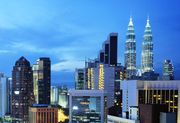
The early years of independence were marred by conflict with Indonesia (Konfrontasi) over the formation of Malaysia, Singapore's eventual exit in 1965, and racial strife in the form of racial riots in 1969. The Philippines also made an active claim on Sabah in that period based upon the Sultanate of Brunei's cession of its north-east territories to the Sulu Sultanate in 1704. The claim is still ongoing. After the 13 May racial riots of 1969, the controversial New Economic Policy—intended to increase proportionately the share of the economic pie of the bumiputras ("indigenous people", which includes the majority Malays, but not always the indigenous population) as compared to other ethnic groups—was launched by Prime Minister Abdul Razak. Malaysia has since maintained a delicate ethno-political balance, with a system of government that has attempted to combine overall economic development with political and economic policies that promote equitable participation of all races.
Between the 1980s and the mid 1990s, Malaysia experienced significant economic growth under the premiership of Mahathir bin Mohamad. The period saw a shift from an agriculture-based economy to one based on manufacturing and industry in areas such as computers and consumer electronics. It was during this period, too, that the physical landscape of Malaysia has changed with the emergence of numerous mega-projects. The most notable of these projects are the Petronas Twin Towers (at the time the tallest building in the world), KL International Airport (KLIA), North-South Expressway, the Sepang F1 Circuit, the Multimedia Super Corridor (MSC), the Bakun hydroelectric dam and Putrajaya, a new federal administrative capital.
In the late 1990s, Malaysia was shaken by the Asian financial crisis as well as political unrest caused by the sacking of the deputy prime minister Dato' Seri Anwar Ibrahim. In 2003, Dr Mahathir, Malaysia's longest serving prime minister, retired in favour of his deputy, Abdullah Ahmad Badawi. On November 2007 Malaysia was rocked by two anti-government rallies. The 2007 Bersih Rally numbering 40,000 strong was held in Kuala Lumpur, Malaysia, on November 10 campaigning for electoral reform. It was precipitated by allegations of corruption and discrepancies in the Malaysian election system that heavily favour the ruling political party, Barisan Nasional, which has been in power since Malaysia achieved its independence in 1957. The 2007 HINDRAF rally was held in Kuala Lumpur on 25 November. The rally organizer, the Hindu Rights Action Force, had called the protest over alleged discriminatory policies which favour ethnic Malays. The crowd was estimated to be between 5,000 to 30,000. In both cases the government and police were heavy handed and tried to prevent the gatherings from taking place.
Government and politics
Malaysia is a federal constitutional elective monarchy. The federal head of state of Malaysia is the Yang di-Pertuan Agong, commonly referred to as the King of Malaysia. The Yang di-Pertuan Agong is elected to a five-year term among the nine hereditary Sultans of the Malay states; the other four states, which have titular Governors, do not participate in the selection.
The system of government in Malaysia is closely modeled on that of Westminster parliamentary system, a legacy of British colonial rule. In practice however, more power is vested in the executive branch of government than in the legislative, and the judiciary has been weakened by sustained attacks by the government during the Mahathir era. Since independence in 1957, Malaysia has been governed by a multi-party coalition known as the Barisan Nasional (formerly known as the Alliance).
Legislative power is divided between federal and state legislatures. The bicameral parliament consists of the lower house, the House of Representatives or Dewan Rakyat (literally the "Chamber of the People") and the upper house, the Senate or Dewan Negara (literally the "Chamber of the Nation"). The 222-member House of Representatives are elected from single-member constituencies that are drawn based on population for a maximum term of five years. All 70 Senators sit for three-year terms; 26 are elected by the 13 state assemblies, two representing the federal territory of Kuala Lumpur, one each from federal territories of Labuan and Putrajaya, and 40 are appointed by the king. Besides the Parliament at the federal level, each state has a unicameral state legislative chamber ( Malay: Dewan Undangan Negeri) whose members are elected from single-member constituencies. Parliamentary elections are held at least once every five years, with the last general election being in March 2008. The cabinet is chosen from among members of both houses of Parliament and is responsible to that body.
State governments are led by Chief Ministers ( Menteri Besar in Malay states or Ketua Menteri in states without hereditary rulers), who is a state assembly member from the majority party in the Dewan Undangan Negeri. In each of the states with a hereditary ruler, the Chief Minister is required to be a Malay Muslim, although this rule is subject the rulers' discretions.
Citizenship
Most Malaysians are granted citizenship by lex soli. All Malaysians are Federal citizens with no formal citizenships within the individual states, except for the states of Sabah and Sarawak and the federal territory of Labuan in East Malaysia, where state citizenship is a privilege and distinguishable from the Peninsula. Every citizen is issued a biometric smart chip identity card, known as MyKad, at the age of 12, and must carry the card at all times. A citizen is required to present his or her identity card to the police, or in the case of an emergency, to any military personnel, to be identified. If the card cannot be produced immediately, the person technically has 24 hours under the law to produce it at the nearest police station.
Administrative divisions
Administratively, Malaysia consists of 13 states (11 in Peninsular Malaysia and 2 in Malaysian Borneo) and 3 federal territories.
Geography
The two distinct parts of Malaysia, separated from each other by the South China Sea, share a largely similar landscape in that both West and East Malaysia feature coastal plains rising to often densely forested hills and mountains, the highest of which is Mount Kinabalu at 4,095.2 metres (13,435.7 ft) on the island of Borneo. The local climate is equatorial and characterized by the annual southwest (April to October) and northeast (October to February) monsoons.
Tanjung Piai, located in the southern state of Johor, is the southernmost tip of continental Asia.
The Strait of Malacca, lying between Sumatra and Peninsular Malaysia, is arguably the most important shipping lane in the world.
Putrajaya is the newly created administrative capital for the federal government of Malaysia, aimed in part to ease growing congestion within Malaysia's capital city, Kuala Lumpur. Kuala Lumpur remains the seat of parliament, as well as the commercial and financial capital of the country. Other major cities include George Town, Ipoh, Johor Bahru, Kuching, Kota Kinabalu, Miri, Alor Star, Malacca Town, and Klang.
Demographics
Malaysia's population comprises many ethnic groups, with the Malays and other bumiputra groups in Sabah and Sarawak making up the majority, at 65% of the population. By constitutional definition, Malays are Muslims who practice Malay customs (adat) and culture. Therefore, technically, a Muslim of any race who practices Malay customs and culture can be considered a Malay and have equal rights when it comes to Malay rights as stated in the constitution. Non-Malay bumiputra groups make up more than half of the state of Sarawak's population (of which 30% are Ibans), and close to 60% of Sabah's population (of which 18% are Kadazan-Dusuns, and 17% are Bajaus). There also exist aboriginal groups in much smaller numbers on the Peninsula, where they are collectively known as Orang Asli.
26% of the population are Malaysians of Chinese descent, while Malaysians of Indian descent comprise 8% of the population. The majority of the Indian community are Tamils but various other groups are also present, including Malayalis, Punjabis and Gujaratis. Other Malaysians also include those whose origin, inter alia, can be traced to the Middle East, Thailand and Indonesia. Europeans and Eurasians include British who settled in Malaysia since colonial times, and a strong Portuguese community in Malacca. A small number of Cambodians and Vietnamese also settled in Malaysia as Vietnam War refugees.
Population distribution is uneven, with some 20 million residents concentrated on the Malay Peninsula, while East Malaysia is relatively less populated. Due to the rise in labour intensive industries, Malaysia has 10 to 20% foreign workers with the uncertainty due in part to the large number of illegal workers, mostly Indonesian. There are a million legal foreign workers and perhaps another million unauthorized foreigners. The state of Sabah alone has nearly 25% of its 2.7 million population listed as illegal foreign workers in the last census. However, this figure of 25% is thought to be less than half the figure speculated by NGOs.
Additionally, according to the World Refugee Survey 2008, published by the U.S. Committee for Refugees and Immigrants, Malaysia hosts a population of refugees and asylum seekers numbering approximately 155,700. Of this population, approximately 70,500 refugees and asylum seekers are from the Philippines, 69,700 from Myanmar, and 21,800 from Indonesia. The U.S. Committee for Refugees and Immigrants named Malaysia as one of the Ten Worst Places for Refugees on account of the country's discriminatory practices toward refugees. Malaysian officials are reported to have turned deportees directly over to human smugglers in 2007, and Malaysia employs the RELA, a volunteer militia, to enforce its immigration law.
Religion
Malaysia is a multi-religious society and Islam is the official religion. According to the Population and Housing Census 2000 figures, approximately 60.4 percent of the population practiced Islam; 19.2 percent Buddhism; 9.1 percent Christianity; 6.3 percent Hinduism; and 2.6 percent traditional Chinese religions. The remaining 2 percent was accounted for by other faiths, including Animism and Sikhism. Until the twentieth century, most practiced traditional beliefs, which arguably still linger on to a greater degree than Malaysian officialdom is prepared to acknowledge.
Although the Malaysian constitution theoretically guarantees religious freedom, in practice the situation is restricted. All ethnic Malays are Muslim as defined in the Malaysian constitution. Additionally, all non-Muslims who marry a Muslim must renounce their religion and convert to Islam. Meanwhile, non-Muslims experience restrictions in activities such as construction of religious buildings and the celebration of certain religious events in some states. Muslims are obliged to follow the decisions of Sharia courts when it comes to matters concerning their religion. The jurisdiction of Sharia court is limited only to Muslims over matters of Faith and Obligations as a Muslim, which includes marriage, inheritance, apostasy, conversion, and custody among others. No other criminal or civil offences are under the jurisdiction of the Sharia Courts. As a rule, the Civil Courts cannot overrule any decision made by the Sharia Courts - not even the Federal Court. The Sharia Courts have a similar hierarchy to the Civil Courts.
Education
Education in Malaysia is monitored by the federal government Ministry of Education.
Most Malaysian children start schooling between the ages of three to six, in kindergarten. Most kindergartens are run privately, but there are a few government-operated kindergartens.
Children begin primary schooling at the age of seven for a period of six years. There are two major types of government-operated or government-assisted primary schools. They are the national schools (Sekolah Kebangsaan) which use Malay as the medium of instruction, and the national-type schools (Sekolah Jenis Kebangsaan) which use either Chinese or Tamil as the medium of instruction. Before progressing to the secondary level of education, students in Year 6 used to be required to sit for the Ujian Pencapaian Sekolah Rendah (UPSR), or Primary School Assessment Examination. An exam called Penilaian Tahap Satu (PTS), First Level Assessment, was used to measure the ability of bright students, and to allow them to move from Year 3 to 5, skipping Year 4. However, this exam was removed in 2001.
Secondary education in government secondary schools lasts for five years. Government secondary schools use Malay as the main medium of instruction. The only exceptions are the Maths and Science subjects as well as languages other than Malay. At the end of the third year or Form Three, students sit for the Penilaian Menengah Rendah (PMR), Lower Secondary Assessment. The combination of subjects available to Form 4 students vary from one school to another. In the last year (Form 5), students sit for Sijil Pelajaran Malaysia (SPM), Malaysian Certificate of Education, which is equivalent to the British Ordinary or 'O' Levels (now referred to as GCSE). The oldest in Malaysia is Penang Free School. Penang Free School is also the oldest school in South East Asia.
Mathematics and Science subjects in government primary and secondary schools such as Biology, Physics, and Chemistry are taught in English. The reasoning was that students would no longer be hindered by the language barrier during their tertiary education in fields such as medicine and engineering.
There are also 60 Chinese Independent High Schools in Malaysia, where most subjects are taught in Chinese. Chinese Independent High Schools are monitored and standardised by the United Chinese School Committees' Association of Malaysia (UCSCAM, more commonly referred to by its Chinese name, Dong Zong 董总), however, unlike government schools, every independent school is free to make its own decisions. Studying in independent schools takes 6 years to complete, divided into Junior Middle (3 years) and Senior Middle (3 years). Students sit for a standardised test by Dong Zong known as the Unified Examination Certificate (UEC) in Junior Middle 3 (equivalent to PMR) and Senior Middle 3 (equivalent to AO level). A number of independent schools conduct classes in Malay and English in addition to Chinese, enabling the students to sit for the PMR and SPM as well.
Malaysia's secondary schools are grouped into a few types, namely national schools which include daily schools and religious schools, Chinese independent schools, technical schools, residential schools, Mara Junior Science College and private-funding schools such as religious schools, international schools and private schools.
Students who wish to enter public universities must complete one and a half more years of secondary schooling in Form Six and sit for the Sijil Tinggi Persekolahan Malaysia (STPM), Malaysian Higher School Certificate; equivalent to the British Advanced or 'A' levels.
As for tertiary education, there are public universities such as University of Malaya, Universiti Sains Malaysia and Universiti Kebangsaan Malaysia. In addition, five international reputable universities have set up their branch campuses in Malaysia since 1998. A branch campus can be seen as an ‘off-shore campus’ of the foreign university, which offers the same courses and awards as the main campus. Both local and international students can acquire these identical foreign qualifications in Malaysia for a cheaper price. The foreign university branch campuses in Malaysia are: Monash University Malaysia Campus, Curtin University of Technology Sarawak Campus, Swinburne University of Technology Sarawak Campus and University of Nottingham Malaysia Campus.
Students also have the option of enrolling in private colleges after secondary studies. Most colleges have educational links with overseas universities especially in the United States, the United Kingdom and Australia. Malaysian students abroad study mostly in the UK, United States, Australia, New Zealand, Canada, Singapore, and Japan.
In addition to the National Curriculum, Malaysia has many international schools. International schools offer students the opportunity to study the curriculum of another country. These schools mainly cater to the growing expatriate population in the country. International schools include: the Australian International School, Malaysia (Australian curriculum), The Alice Smith School (British Curriculum), elc International school (British Curriculum), The Garden International School (British Curriculum), Lodge International School (British Curriculum), The International School of Kuala Lumpur (International Baccalaureate and American Curriculum), The Japanese School of Kuala Lumpur (Japanese Curriculum), The International School of Penang (International Baccalaureate and British Curriculum), Lycée Français de Kuala Lumpur (French Curriculum) amongst others.
Healthcare
Malaysian society places importance on the expansion and development of health care, putting 5% of the government social sector development budget into public health care—an increase of more than 47% over the previous figure. This has meant an overall increase of more than RM 2 billion. With a rising and aging population, the Government wishes to improve in many areas including the refurbishment of existing hospitals, building and equipping new hospitals, expansion of the number of polyclinics, and improvements in training and expansion of telehealth. Over the last couple of years they have increased their efforts to overhaul the systems and attract more foreign investment.
The Malaysian health care system requires doctors to perform a compulsory three years service with public hospitals to ensure the manpower of these hospitals is maintained. Recently foreign doctors have also been encouraged to take up employment here. There is still, however, a compound shortage of medical workforce, especially that of highly trained specialists resulting in certain medical care and treatment only available in large cities. Recent efforts to bring many facilities to other towns have been hampered by lack of expertise to run the available equipment made ready by investments.
The majority of private hospitals are in urban areas and, unlike many of the public hospitals, are equipped with the latest diagnostic and imaging facilities. Private hospitals have not generally been seen as an ideal investment—it has often taken up to ten years before companies have seen any profits. However, the situation has now changed and companies are now looking into this area again, particularly in view of the increasing interest by foreigners in coming to Malaysia for medical care and the recent government focus to develop the health tourism industry.
Currently, private Malaysia Hospitals are looking at international healthcare accreditation, which may be Australian, British or American sourced.
Economy
See Also: Gas Subsidies
The Malay Peninsula and indeed Southeast Asia has been a centre of trade for centuries. Various items such as porcelain and spices were actively traded even before Malacca and Singapore rose to prominence.
In the 17th century, they were found in several Malay states. Later, as the British started to take over as administrators of Malaya, rubber and palm oil trees were introduced for commercial purposes. Over time, Malaya became the world's largest major producer of tin, rubber, and palm oil. These three commodities, along with other raw materials, firmly set Malaysia's economic tempo well into the mid-20th century.
Instead of relying on the local Malays as a source of labour, the British brought in Chinese and Indians to work on the mines and plantations. Although many of them returned to their respective home countries after their agreed tenure ended, some remained in Malaysia and settled permanently.
As Malaya moved towards independence, the government began implementing economic five-year plans, beginning with the First Malayan Five Year Plan in 1955. Upon the establishment of Malaysia, the plans were re-titled and renumbered, beginning with the First Malaysia Plan in 1965.
In 1970s, Malaysia began to imitate the four Asian Tiger economies (Taiwan, South Korea, Hong Kong and Singapore) and committed itself to a transition from being reliant on mining and agriculture to an economy that depends more on manufacturing. With Japanese investment, heavy industries flourished and in a matter of years, Malaysian exports became the country's primary growth engine. Malaysia consistently achieved more than 7% GDP growth along with low inflation in the 1980s and the 1990s.
During the same period, the government tried to eradicate poverty with the controversial New Economic Policy (NEP), after the May 13 Incident of racial rioting in 1969. Its main objective was the elimination of the association of race with economic function, and the first five-year plan to begin implementing the NEP was the Second Malaysia Plan. The success or failure of the NEP is the subject of much debate, although it was officially retired in 1990 and replaced by the National Development Policy (NDP). Recently much debate has surfaced once again with regards to the results and relevance of the NEP. Some have argued that the NEP has indeed successfully created a Middle/Upper Class of Malay businessmen and professionals. Despite some improvement in the economic power of Malays in general, the Malaysian government maintains a policy of discrimination that favors ethnic Malays over other races—including preferential treatment in employment, education, scholarships, business, access to cheaper housing and assisted savings. This special treatment has sparked envy and resentment between non-Malays and Malays.
The Chinese control of the locally-owned sector of the country's economy, meanwhile, has been ceded largely in favour of the Bumiputras/Malays in many essential or strategic industries such as petroleum retailing, transportation, agriculture and etc. The minority of Indian descent has by and large been the most adversely affected by this policy. Indicators point to a higher incidence of crime and gang related activities among the Indians in recent years.
The rapid economic boom led to a variety of supply problems, however. Labour shortages soon resulted in an influx of millions of foreign workers, many illegal. Cash-rich PLCs and consortia of banks eager to benefit from increased and rapid development began large infrastructure projects. This all ended when the Asian Financial Crisis hit in the fall of 1997, delivering a massive shock to Malaysia's economy.
As with other countries affected by the crisis, there was speculative short-selling of the Malaysian currency, the ringgit. Foreign direct investment fell at an alarming rate and, as capital flowed out of the country, the value of the ringgit dropped from MYR 2.50 per USD to, at one point, MYR 4.80 per USD. The Kuala Lumpur Stock Exchange's composite index plummeted from approximately 1300 points to around 400 points in a matter of weeks. After the controversial sacking of finance minister Anwar Ibrahim, a National Economic Action Council was formed to deal with the monetary crisis. Bank Negara imposed capital controls and pegged the Malaysian ringgit at 3.80 to the US dollar. Malaysia refused economic aid packages from the International Monetary Fund (IMF) and the World Bank, however, surprising many analysts.
In March 2005, the United Nations Conference on Trade and Development (UNCTAD) published a paper on the sources and pace of Malaysia's recovery, written by Jomo K.S. of the applied economics department, University of Malaya, Kuala Lumpur. The paper concluded that the controls imposed by Malaysia's government neither hurt nor helped recovery. The chief factor was an increase in electronics components exports, which was caused by a large increase in the demand for components in the United States, which was caused, in turn, by a fear of the effects of the arrival of the year 2000 ( Y2K) upon older computers and other digital devices.
However, the post Y2K slump of 2001 did not affect Malaysia as much as other countries. This may have been clearer evidence that there are other causes and effects that can be more properly attributable for recovery. One possibility is that the currency speculators had run out of finance after failing in their attack on the Hong Kong dollar in August 1998 and after the Russian ruble collapsed. (See George Soros)
Regardless of cause/effect claims, rejuvenation of the economy also coincided with massive government spending and budget deficits in the years that followed the crisis. Later, Malaysia enjoyed faster economic recovery compared to its neighbours. In many ways, however, the country has yet to recover to the levels of the pre-crisis era.
While the pace of development today is not as rapid, it is seen to be more sustainable. Although the controls and economic housekeeping may not have been the principal reason for recovery, there is no doubt that the banking sector has become more resilient to external shocks. The current account has also settled into a structural surplus, providing a cushion to capital flight. Asset prices are now a fraction of their pre-crisis heights.
The fixed exchange rate was abandoned in July 2005 in favour of a managed floating system within an hour of China's announcing of the same move. In the same week, the ringgit strengthened a percent against various major currencies and was expected to appreciate further. As of December 2005, however, expectations of further appreciation were muted as capital flight exceeded USD 10 billion.
In September 2005, Sir Howard J. Davies, director of the London School of Economics, at a meeting in Kuala Lumpur, cautioned Malaysian officials that if they want a flexible capital market, they will have to lift the ban on short-selling put into effect during the crisis. In March 2006, Malaysia removed the ban on short selling. Currently, Malaysia is considered a newly industrialized country.
Infrastructure
Malaysia has extensive roads that connect all major cities and towns on the western coast of Peninsular Malaysia. As of 2006, the total length of the Malaysian expressway network is 1471.6 kilometres (914.4 miles). The network connects all major cities and conurbations such as Klang Valley, Johor Bahru and Penang to each other. The major expressway, the North-South Expressway spans from the northern and the southern tips of Peninsular Malaysia at Bukit Kayu Hitam and Johor Bahru respectively. It is a part of the Asian Highway Network, which also connects into Thailand and Singapore.
Roads in the East Malaysia and the eastern coast of Peninsular Malaysia are still relatively undeveloped. Those are highly curved roads passing through mountainous regions and many are still unsealed, gravel roads. This has resulted in the continued use of rivers and the necessary use of airplanes as the main or alternative mode of transportation for the interior residents.
Train service in West Malaysia is operated by the Keretapi Tanah Melayu (Malayan Railways) and has extensive railroads that connect all major cities and towns on the peninsular, including Singapore. There is also a short railway in Sabah operated by Sabah State Railway that mainly carries freight.
There are seaports throughout the country. The major ports are Port Klang and Port of Tanjung Pelepas in Johor. Other important ports can be found in Tanjung Kidurong, Kota Kinabalu, Kuching, Kuantan, Pasir Gudang, Penang, Miri, Sandakan and Tawau.
Airports are also found throughout the country. Kuala Lumpur International Airport (KLIA) is the main airport of the country. Other important airports include Kota Kinabalu International Airport, Penang International Airport, Kuching International Airport, Langkawi International Airport, and Senai International Airport. There are also airports in smaller towns, as well as small domestic airstrips in rural Sabah and Sarawak. There are daily flight services between West and East Malaysia, which is the only convenient option for passengers travelling between the two parts of the country. Malaysia is the home of the first low-cost carrier in the region, AirAsia. It has Kuala Lumpur as its hub and maintains flights to Southeast Asia and China as well. In KL it operates out of the Low Cost Carrier Terminal (LCCT) in KLIA.
The intercity telecommunication service is provided on Peninsular Malaysia mainly by microwave radio relay. International telecommunications are provided through submarine cables and satellite. One of the largest and most significant telecommunication companies in Malaysia is Telekom Malaysia (TM), providing products and services from fixed line, mobile as well as dial-up and broadband Internet access service. It has the near-monopoly of fixed line phone service in the country.
In December 2004, Energy, Water and Communications Minister Datuk Seri Dr Lim Keng Yaik reported that only 0.85% or 218,004 people in Malaysia used broadband services. However these values are based on subscriber number, whilst household percentage can reflect the situation more accurately. This represented an increase from 0.45% in three quarters. He also stated that the government targeted usage of 5% by 2006 and doubling to 10% by 2008. Lim Keng Yaik had urged local telecommunication companies and service provider to open up the last mile and lower prices to benefit the users.
Culture
Malaysia is a multi-ethnic, multi-cultural and multilingual society. The population as of February 2007 is 26.6 million consisting of 62% Malays, 24% Chinese, 8% Indians, with other minorities and indigenous peoples (Dept of Stats. Malaysia). Ethnic tensions have been rising in recent months.
The Malays, who form the largest community, are defined as Muslims in the Constitution of Malaysia. The Malays play a dominant role politically and are included in a grouping identified as bumiputra. Their native language is Malay (Bahasa Melayu). Malay is the national language of the country.
In the past, Malays wrote in Sanskrit or using Sanskrit-based alphabets. After the 15th century, Jawi (a script based on Arabic) became popular. Over time, romanized script overtook Sanskrit and Jawi as the dominant script. This was largely due to the influence of the colonial education system, which taught children in romanised writing rather than in Arabic script.
The largest non-Malay indigenous tribe is the Iban of Sarawak, who number over 600,000. Some Iban still live in traditional jungle villages in long houses along the Rajang and Lupar rivers and their tributaries, although many have moved to the cities. The Bidayuhs, numbering around 170,000, are concentrated in the southwestern part of Sarawak. The largest indigenous tribe in Sabah is the Kadazan. They are largely Christian subsistence farmers. The 140,000 Orang Asli, or aboriginal peoples, comprise a number of different ethnic communities living in Peninsular Malaysia. Traditionally nomadic hunter-gatherers and agriculturalists, many have been sedentarised and partially absorbed into modern Malaysia.
The Chinese population in Malaysia is mostly Buddhist (of Mahayana sect) or Taoist. Chinese in Malaysia speak a variety of Chinese dialects including Mandarin Chinese, Hokkien, Cantonese, Hakka and Teochew. A large majority of Chinese in Malaysia, especially those from larger cities such as Kuala Lumpur, Petaling Jaya and Penang speak English as well. There has also been an increasing number of the present generation Chinese who consider English as their first language. Chinese have historically been dominant in the Malaysian business community.
The Indians in Malaysia are mainly Hindu Tamils from southern India who native language is Tamil, there are also other Indian communities which is Telugu, Malayalam and Hindi-speaking, living mainly in the larger towns on the west coast of the peninsula. Many middle to upper-middle class Indians in Malaysia also speak English as a first language. A vigorous 200,000-strong Tamil Muslim community also thrives as an independent subcultural group.there are also prevalent Tamil christian communities in major cities and towns. There is also a sizable Sikh community in Malaysia of over 83,000. Most Indians originally migrated from India as traders, teachers or other skilled workers. A larger number were also part of the forced migrations from India by the British during colonial times to work in the plantation industry.
Eurasians, Cambodians, Vietnamese, and indigenous tribes make up the remaining population. A small number of Eurasians, of mixed Portuguese and Malay descent, speak a Portuguese-based creole, called Papiá Kristang. There are also Eurasians of mixed Filipino and Spanish descent, mostly in Sabah. Descended from immigrants from the Philippines, some speak Chavacano, the only Spanish-based creole language in Asia. Cambodians and Vietnamese are mostly Buddhists (Cambodians of Theravada sect and Vietnamese, Mahayana sect).
Malaysian traditional music is heavily influenced by Chinese and Islamic forms. The music is based largely around the gendang (drum), but includes other percussion instruments (some made of shells); the rebab, a bowed string instrument; the serunai, a double-reed oboe-like instrument; flutes, and trumpets. The country has a strong tradition of dance and dance dramas, some of Thai, Indian and Portuguese origin. Other artistic forms include wayang kulit (shadow puppet theatre), silat (a stylised martial art) and crafts such as batik, weaving, including the ceremonial cloth pua kumbu, and silver and brasswork.
Holidays
Malaysians observe a number of holidays and festivities throughout the year. Some holidays are federal gazetted public holidays and some are public holidays observed by individual states. Other festivals are observed by particular ethnic or religion groups, but are not public holidays.
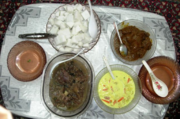
The most celebrated holiday is the " Hari Merdeka" (Independence Day) on August 31 commemorating the independence of the Federation of Malaya in 1957, while Malaysia Day is only celebrated in the state of Sabah on September 16 to commemorate the formation of Malaysia in 1963. Hari Merdeka, as well as Labour Day ( May 1), the King's Birthday (first Saturday of June) and some other festivals are federal gazetted public holidays.
Muslims in Malaysia celebrate Muslim holidays. The most celebrated festival, Hari Raya Puasa (also called Hari Raya Aidilfitri) is the Malay translation of Eid al-Fitr. It is generally a festival honoured by the Muslims worldwide marking the end of Ramadan, the fasting month. In addition to Hari Raya Puasa, they also celebrate Hari Raya Haji (also called Hari Raya Aidiladha, the translation of Eid ul-Adha), Awal Muharram ( Islamic New Year) and Maulidul Rasul (Birthday of the Prophet).
Chinese in Malaysia typically celebrate festivals that are observed by Chinese around the world. Chinese New Year is the most celebrated among the festivals which lasts for fifteen days and ends with Chap Goh Mei. Other festivals celebrated by Chinese are the Qingming Festival, the Dragon Boat Festival and the Mid-Autumn Festival. In addition to traditional Chinese festivals, Buddhists Chinese also celebrate Vesak.
The majority of Indians in Malaysia are Hindus and they celebrate Diwali, the festival of light, while Thaipusam is a celebration which pilgrims from all over the country flock to Batu Caves. Apart from the Hindus, Sikhs celebrate the Vaisakhi, the Sikh New Year.
Other festivals such as Good Friday (East Malaysia only), Christmas, Hari Gawai of the Ibans ( Dayaks), Pesta Menuai (Pesta Kaamatan) of the Kadazan-Dusuns are also celebrated in Malaysia.
Despite most of the festivals being identified with a particular ethnic or religious group, all Malaysians celebrate the festivities together, regardless of their background. For years, when Hari Raya Puasa and Chinese New Year coincided, a slogan, Kongsi Raya, a combination of Gong Xi Fa Cai (a greeting used on the Chinese New Year) and Hari Raya (which could also mean "celebrating together" in Malay language) was coined. For years when the Hari Raya Puasa and Deepavali coincide, a slogan, Deepa Raya, is similarly coined.


